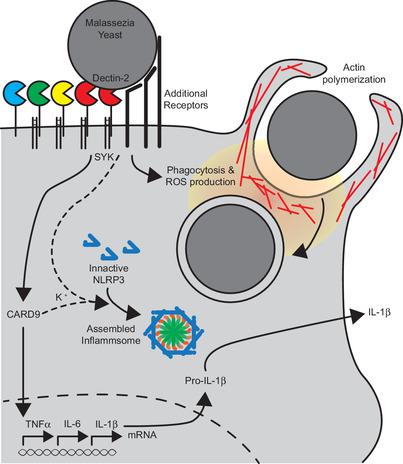当前位置:
X-MOL 学术
›
J. Leukoc. Biol.
›
论文详情
Our official English website, www.x-mol.net, welcomes your feedback! (Note: you will need to create a separate account there.)
Malassezia spp. induce inflammatory cytokines and activate NLRP3 inflammasomes in phagocytes.
Journal of Leukocyte Biology ( IF 5.5 ) Pub Date : 2020-09-17 , DOI: 10.1002/jlb.2ma0820-259r Andrea J Wolf 1 , Jose J Limon 1 , Christopher Nguyen 1 , Alexander Prince 1 , Anthony Castro 1 , David M Underhill 1
Journal of Leukocyte Biology ( IF 5.5 ) Pub Date : 2020-09-17 , DOI: 10.1002/jlb.2ma0820-259r Andrea J Wolf 1 , Jose J Limon 1 , Christopher Nguyen 1 , Alexander Prince 1 , Anthony Castro 1 , David M Underhill 1
Affiliation

|
Malassezia spp. are common eukaryotic yeasts that colonize mammalian skin. Recently, the authors and others have observed that Malassezia globosa and Malassezia restricta can be found in the intestines in the context of certain diseases, including Crohn's disease and pancreatic cancer. In order to better understand the nature of innate inflammatory responses to these yeasts, inflammatory responses induced by M. restricta and M. globosa in mouse bone marrow‐derived Mϕs (BMDM) and dendritic cells (BMDC) are evaluated. While Malassezia yeasts induce proinflammatory cytokine production from both Mϕs and dendritic cells, the levels of production from BMDC were more pronounced. Both M. restricta and M. globosa activated inflammatory cytokine production from BMDC in large part through Dectin2 and CARD9 signaling, although additional receptors appear to be involved in phagocytosis and activation of reactive oxygen production in response to the yeasts. Both M. restricta and M. globosa stimulate production of pro‐IL‐1β as well as activation of the NLRP3 inflammasome. NLRP3 inflammasome activation by Malassezia fungi requires SYK signaling, potassium efflux and actin rearrangement. Together, the data further the understanding of the coordinated involvement of multiple innate immune receptors in recognizing Malassezia globosa and Malassezia restricta and orchestrating phagocyte inflammatory and antimicrobial responses.
中文翻译:

马拉色菌属 诱导炎症细胞因子并激活吞噬细胞中的 NLRP3 炎症小体。
马拉色菌属 是定植哺乳动物皮肤的常见真核酵母。最近,作者和其他人观察到,在某些疾病(包括克罗恩病和胰腺癌)的肠道中可以发现球形马拉色菌和限制性马拉色菌。为了更好地理解的这些酵母先天炎症反应的性质,诱导炎症反应M. restricta和M.藻在小鼠骨髓来源Mφs(BMDM)和树突细胞(BMDC)进行评估。虽然马拉色菌酵母诱导 Mφs 和树突细胞产生促炎细胞因子,但 BMDC 的产生水平更为明显。两个都M. restricta和M.藻激活从BMDC通过Dectin2和CARD9信令大部分炎症性细胞因子的产生,虽然附加的受体似乎涉及在吞噬作用和活性氧产生激活响应于所述酵母。既M. restricta和M.藻刺激产生促IL-1β的以及所述NLRP3炎性体激活。马拉色菌对NLRP3 炎症小体的激活需要 SYK 信号传导、钾外流和肌动蛋白重排。总之,这些数据进一步理解了多种先天免疫受体在识别马拉色菌和限制性马拉色菌中协同参与的理解 并协调吞噬细胞的炎症和抗菌反应。
更新日期:2020-09-17
中文翻译:

马拉色菌属 诱导炎症细胞因子并激活吞噬细胞中的 NLRP3 炎症小体。
马拉色菌属 是定植哺乳动物皮肤的常见真核酵母。最近,作者和其他人观察到,在某些疾病(包括克罗恩病和胰腺癌)的肠道中可以发现球形马拉色菌和限制性马拉色菌。为了更好地理解的这些酵母先天炎症反应的性质,诱导炎症反应M. restricta和M.藻在小鼠骨髓来源Mφs(BMDM)和树突细胞(BMDC)进行评估。虽然马拉色菌酵母诱导 Mφs 和树突细胞产生促炎细胞因子,但 BMDC 的产生水平更为明显。两个都M. restricta和M.藻激活从BMDC通过Dectin2和CARD9信令大部分炎症性细胞因子的产生,虽然附加的受体似乎涉及在吞噬作用和活性氧产生激活响应于所述酵母。既M. restricta和M.藻刺激产生促IL-1β的以及所述NLRP3炎性体激活。马拉色菌对NLRP3 炎症小体的激活需要 SYK 信号传导、钾外流和肌动蛋白重排。总之,这些数据进一步理解了多种先天免疫受体在识别马拉色菌和限制性马拉色菌中协同参与的理解 并协调吞噬细胞的炎症和抗菌反应。


























 京公网安备 11010802027423号
京公网安备 11010802027423号